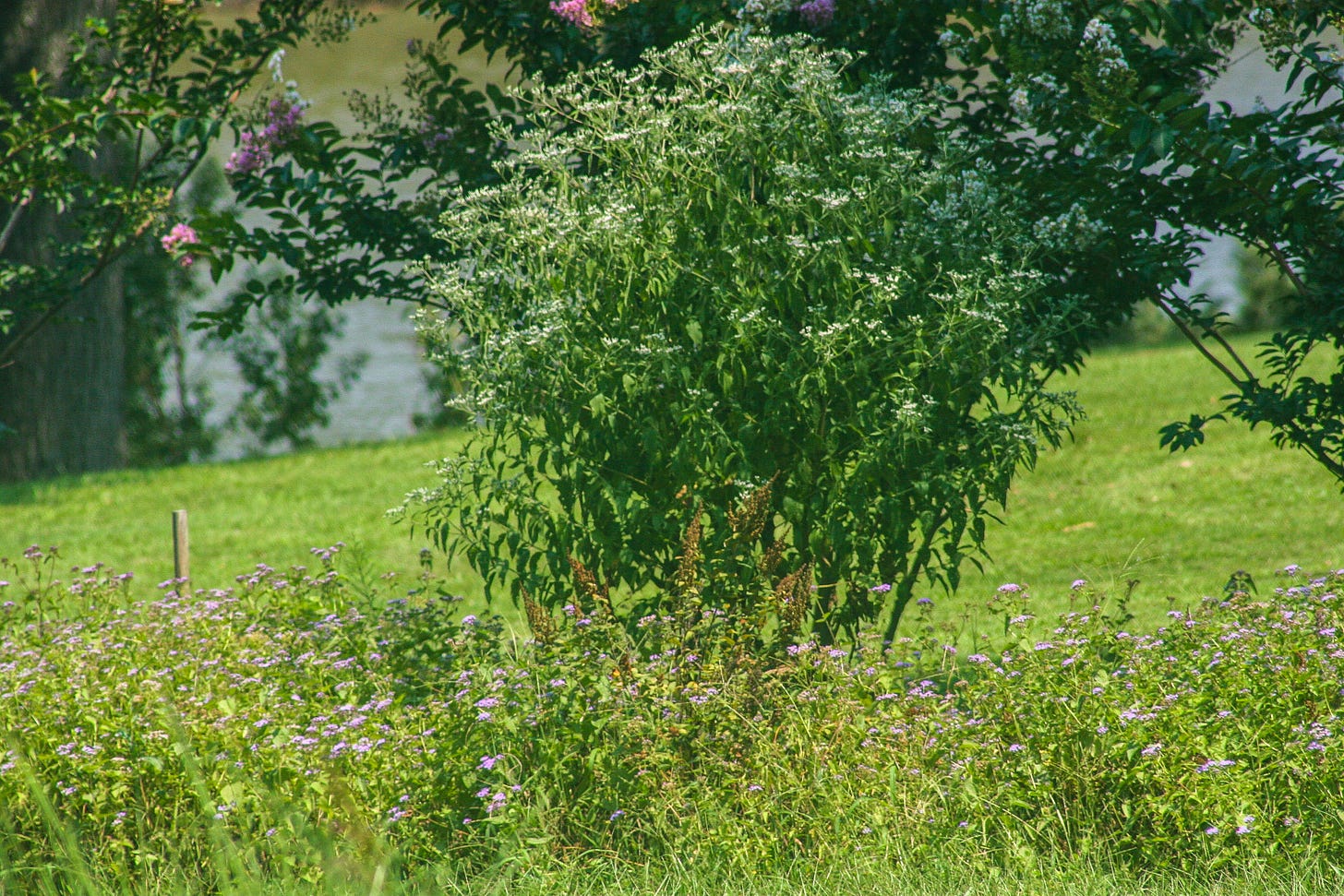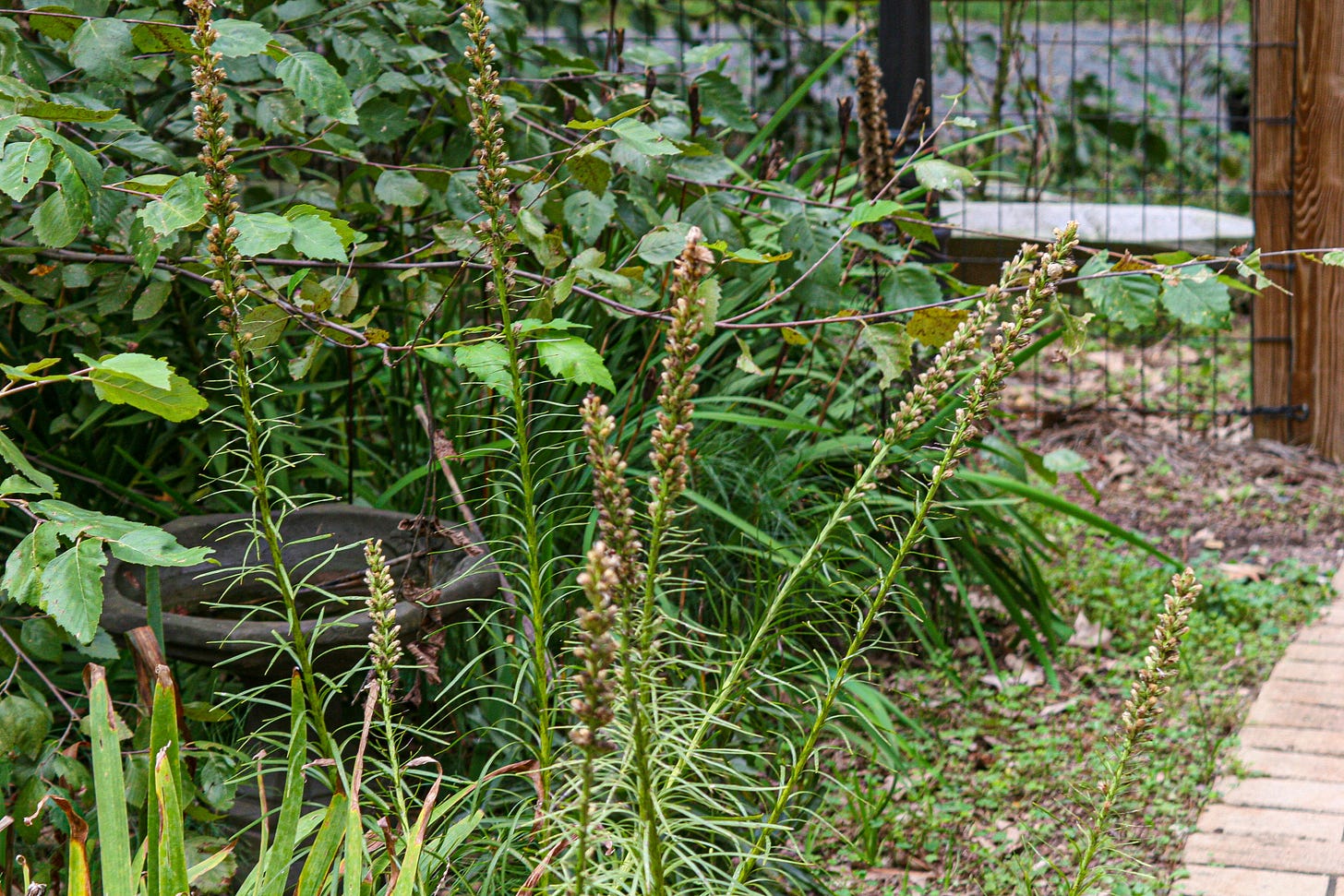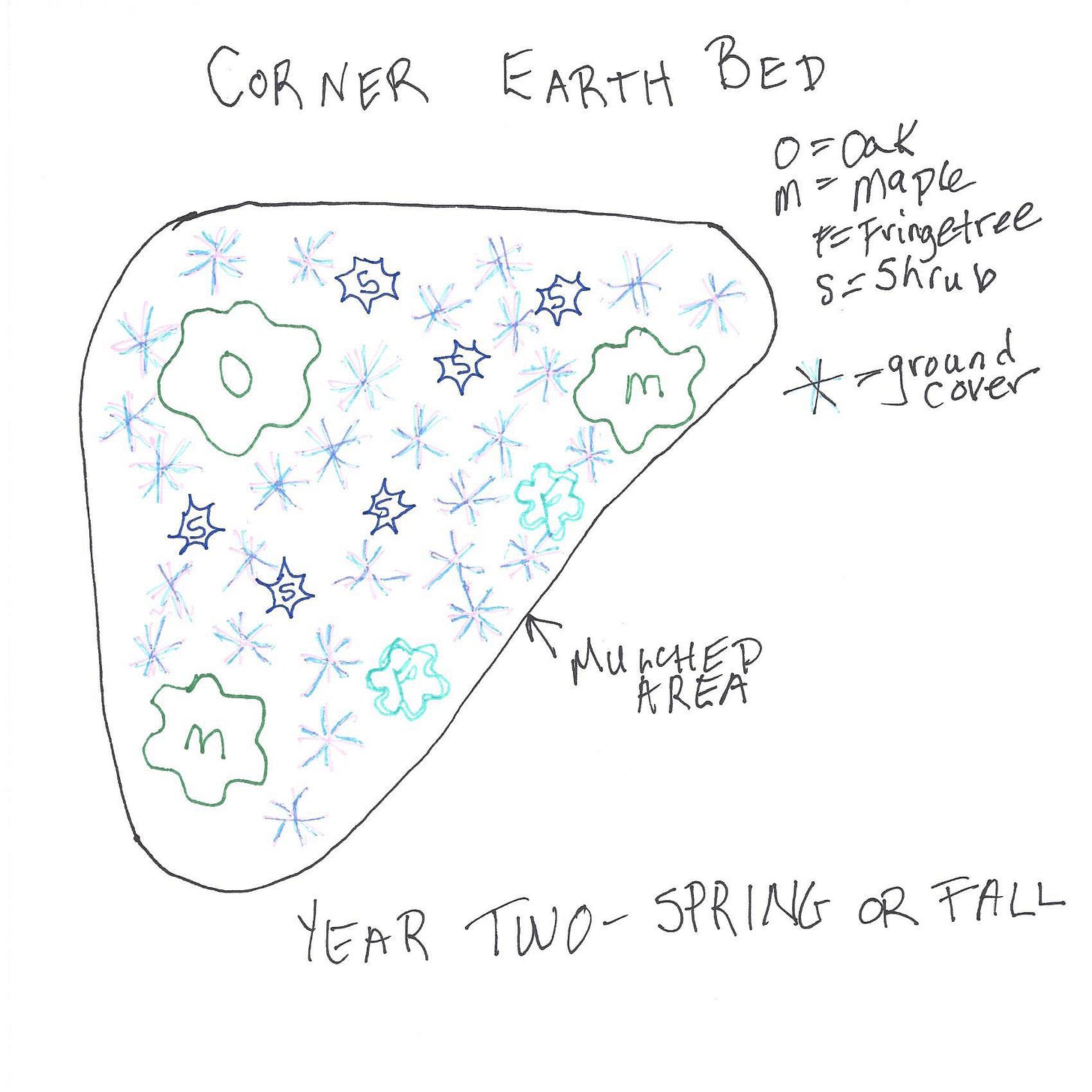Making Earth Beds
“Earth Beds” are what will really distinguish your garden from your Granny’s. In making them, you are flying in the face of many years of yard silliness, which became codified as “normal” some time in the last century.

Earth Beds are areas where many trees, shrubs, and other plants snuggle right up to each other, similar to a forested or semi-forested area. Look carefully at the edges of a forested area - you’ll see trees, shrubs, grasses, all sorts of things growing right on top of each other. That is what we will create in our earth beds, a variety of growing things, with different heights and green plants to cover the ground, rather than the ubiquitous wood mulch. This is common throughout Europe, except perhaps in their inner cities.
It looks better than isolated little plants, too. One tiny tree, surrounded by its little island of mulch, perhaps, looks faintly silly; but surround that tree with other plants, no matter how tiny they are themselves, and you’ve got a grouping that makes a statement in the yard. If they’re all planted in one bed it’s much easier to mow around; you can always enlarge the bed if you care to, adding more and more great plants for birds, etc., and reducing your mowing chores at the same time.
Earth Beds are made on a different plan than the average landscaper would provide. For generations the common “wisdom” was to leave a tremendous footage between any one tree and any other, because, in the absence of “competition” the tree would, eventually, achieve that spread with its branches. That it could easily take 50 - 100 years to do so didn’t stop this advice from reaching all and sundry, with the inevitable result that bare, sun-blasted, deeply parched yards, crying and desperate for cool, life affirming shade, became the norm.

In fact, trees (shrubs, etc.) LOVE nearby companions. Some are very clannish and partial to their own kind, others are more free-wheeling and enjoy everybody. (“Finding the Mother Tree” by Suzanne Simard will give you proof of this. https://suzannesimard.com/finding-the-mother-tree-book/) In reality, though, all you have to do is go to a forested area, even one abutting the road, and look at all that grows there. Happily.
It might strike you - as it certainly would old fashioned Granny - that it looks a bit… messy. But it still looks better than one silly plant; and plants, growing all together, snuggled right up to each other, create a “whole is greater than the sum of the parts” scenario.
When plants are allowed to cover the whole ground, what results for wild creatures is very like a city for us. Out in the farms, if we want designer shoes or an amazing Tanzanian dinner, we have to go to the city where they could be found. In an average, “Granny would approve” yard, small creatures have to seek out those “messy” areas to find what they’re looking for. Their city, which is - where???? Why not make one in your yard?

Mingling plants altogether is not only good for small creatures, like birds, butterflies, and lightning bugs; it’s good for the plants, as well. Isolating plants from each other - even from weeds - prevents them from enjoying the benefits of a community. They all send their roots to different depths, where different nutrients may be available, bringing them up. They also all have differing abilities to absorb nutrients straight from soil. Planted right together, nice and close, snuggled up with a lot of others, is the best case scenario for almost all denizens of the natural world.
Planted all together, the plants actually change the soil. Fungi that enjoy this plant’s roots mingle freely with fungi that enjoy that one’s, eventually becoming one giant life-giving organism. This leads to a sharing of nutrients between all, preventing a lack of some that are absolutely available to another.
A phenomenon known as “mycorrhiza,” which is a symbiotic (good for both partners) relationship between the plant and the fungus will begin.* The fungus can easily extract nutrients, like calcium, etc., but has trouble producing sugar. The fungus happily trades nutrients for the plant’s sugar, which the plant produces in the leaves. The fungi also trade nutrients with each other - which means that the nutrients extracted at whatever depth become available to the entire community. The fungi also help the plants fend off disease and are infamously great at helping plants survive drought. It’s well worth planting communities rather than divas surrounded only by applied mulch.

Nature creates these “messy” areas with wild abandon. We can plan them out, which can actually result in an even better city for wild creatures and we can, if we wish, gently prune or otherwise tweak the area to look less “messy.” In fact, I regularly hear joyous comments from neighbors about our Earth Beds. Yes, there are trees and shrubs and ground covers chasing out every last bit of mulchy extravaganza so popular with Granny. In fact, once we have an Earth Bed going, we seldom, if ever, add any mulch at all. Plants do all that is needed from a mulch, and give so very, very much more (besides being less work and expense). It looks good, and even neighbors just passing by with their dogs can see, and hear, the abundance of birds.

While it’s a bit of work setting up each Earth Bed (a few hours), you will save a great deal of time in all future years. Your mowing chore will be lessened, your mulching chore will be lessened, and it’s likely you will have some shade - glorious, cool, shade! In only a few years, not 50. Wonderful Earth Beds need only a minimum of work - there’s no such thing as a no-work yard, but these come close. You’ll have to check it regularly for invasive plants that might try to set up shop there and get rid of them. You might choose to prune here and there, simply to improve the looks or get rid of any diseased or crossed branches.
Best of all, your children and grandchildren will love the earth beds if you allow them to play there (why not?). Remember playing hide ’n seek? Where, in Granny’s sun-blasted yard, would a child find a good place to hide? With Earth Beds, crouching down under or behind a shrub is great fun. And if it’s shady, you won’t need the sunscreen.
The same “fun” awaits small birds, etc., too. Hide ’n seek is NOT a game to a chickadee. It’s survival. Earth Beds allow chickadees (etc.) to hide while gazing about for dinner, which might literally be at their feet. It’s no wonder our yard, with all its Earth Beds, is full of bird song. They are very happy birds!
Outside of a couple of trees/shrubs, you undoubtedly already have all you need to create an Earth Bed. (See “Getting Rid of Sod”) Below is a “garden plan” for an easy Earth Bed. You can follow it to the letter if you wish, but it’s included mainly so you can see that it really is just as simple as I’ve described.
*You can purchase and apply mycorrhizal inoculants. It’s very easy, they’re even available on Amazon. It’s best to dig the inoculant in when planting, so it forms immediately on the tender roots, but it can also be applied by drenching (pouring liquid straight onto the soil), particularly if you’ve “punctured” the soil surface so that the inoculant can reach the roots quickly. You will only need to do this once. Mycorrhiza inoculant can frequently be found in compost, as the fungi which help break down the matter can work well with plant roots. It’s actually a major benefit of compost.
Simple Earth Bed Plan - Have fun! Personalize it with your own plant choices. You can also do different shapes, etc. - it’s your yard!
Here is a simple plan for an Earth Bed. You don’t need a plan, but it’s nice for first timers. Since yards generally have corners, this plan is set up to cover a corner with great-for-the-Earth plantings. There are several stages, planned for successive planting seasons spring or fall. You can, of course, do it all at once if you’re very motivated, and, if you wish, you can make more complicated plans. You can take advantage of an area you’ve cleared sod from, or plant and then clear the sod around the plantings. Up to you!
Step 1
Here a mulched area is planted with three shade trees. They can be any shade trees you like; if you have a small (l/4 acre or less) yard, you may wish to focus on smaller, “understory” trees instead. That’s up to you; it will be many years before those shade trees are so big they’d cause a problem. The entire time they will clean the air and feed butterfly, moth, and other babies, thus feeding all sorts of birds.
Note the curved edges - curves are easy on the eye and much easier to mow around than corners.
Step 2
Here, the following season, two understory trees are added to the original Earth Bed. Several shrubs are added too (this step can be broken into two steps, with successive seasons if desired). The understory trees and shrubs are improving the diversity of the planting, improving the air, and starting the “multiple heights” of mature plantings that are critical for healthy pollinators and birds.
Here, second year, possibly third if you’re patient, ground covers are added to the mix. Ground covers can be almost anything; we are used to the thought that ground covers are less than 8 inches tall, but there are hundreds of useful plants that will cover the ground nicely that get taller than that. It will help to choose a height limit for these, whatever they are, to ensure smooth looking coverage and discourage a “messy” look if you’ve got fussy neighbors (usually the plan is to go shorter than the shrubs). You can mix plants that are roughly the same height, which will allow spreading the bloom period to perhaps achieve full season bloom.
The next year and beyond, it’s unlikely you’ll need to mulch. Leaves will accumulate in fall and the plants themselves will ensure the soil retains moisture, prevent splash-back onto vulnerable leaves, etc. In other words, you’ll have a “green” mulch. Over time the leaves, etc., will create compost for the whole area.






